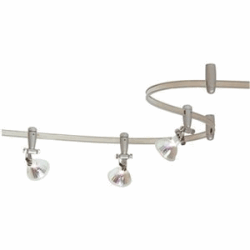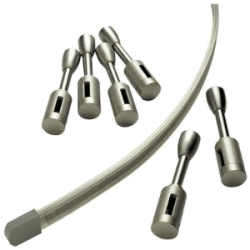Flex Track Lighting: Flexible Kits and Systems for Your Exact Needs
Flex track lighting provides flexible options for lighting hard-to-illuminate areas with a contemporary style.
Flex track lighting is a special type of track lighting. Unlike standard track lighting, which is straight, or standard monorail lighting, which comes in predefined curves and shapes, flex track lighting comes with tracks that can themselves be bent into nearly any shape desired. This provides the maximum of flexibility: you can literally do whatever you want with them. In this article, I will discuss how flexible track lighting works, and then discuss various ways of using it to contribute to your overall lighting design.
The Basics of Flex Track Lighting

Flexible tracks can be bent at sharper angles than you might expect. This model is available at Amazon.
Flexible track lighting works in a similar way to all other track lighting. Rather than provide electricity to each of the individual light sources on the track, the track itself is electrified. Then, light sources, usually low-voltage ones like 12V light bulbs, are strung along the track. Because the light sources can be easily moved, the light provided by track lighting is especially flexible. By combining light sources that can be moved with directed light sources like halogen bulbs that can be pointed in various directions, light can be directed almost anywhere. As a result, track lighting is especially well-suited to museums and art galleries where light sources need to be constantly readjusted to accommodate new exhibits.
As track lighting moved into the home, however, these straight styles tended to be considered too industrial looking by a lot of designers. After all, the track is bare and often one can look directly at the halogen lamps right on the track. To offset these effects, an increasing number of designers moved to curved track lighting. Curved track lighting counter-balances the industrial feel of track lighting by giving it a sleek and fluid appearance. Most of this curved lighting came in monorail kits, in which each piece of track would have a hard track of a given curvature.
Flexible track lighting takes this curvature one step further. Not only are the tracks curved, they are curveable. In other words, you are able to curve track to exactly the specification that you desire. As a result, placing tracks exactly where you want them is easier than ever. With a monorail kit, figuring out how to make interesting shapes was like a mixture of a jigsaw and a Sudoku puzzle, because you had to figure out which curves should go in which position to get the appropriate effect, if that was even possible. Flex track lighting allows you to shape the track in whichever way that you want.
Flex Track Lighting Kits and Systems
Flexible track lighting kits will include at least two parts: a track and supports. However, the majority will also include lighting fixtures, connectors, end caps and transformers. The role of each is the following:

Tracks are bent into the desired shape, and then attached using connectors and end caps. This set of pieces is available at Amazon.
- The Track: The track will usually come in several sections, each of which can be bent up to a certain curvature. This track is electrified when the lights are active.
- Supports: Supports actually connect the track to the ceiling. After bending the track to the appropriate shape, you will affix the track to the ceiling using these supports.
- Lighting Fixtures: Most flex track systems will include lighting fixtures, though these can often be removed and replaced with other fixtures if you like. Just make sure that the new fixtures use the same voltage as the old fixtures.
- Transformers: Since virtually all track lighting is low-voltage, you will need a transformer so that your household current will not blow out your track lighting. Some flex track kits will not include transformers if they do not include fixtures.
- Connectors: Connectors are used to connect the pieces of track together into a whole track.
- End Caps: End caps are placed at the end of the track.
Once you have your flex track lighting system, you should consider where you would like to put it. For instance, is your goal to use it as a decorative object at the center of your living room or is it for task lighting in your kitchen? If your goal is decorative, try to produce a fixture that is as attractive as possible (I will give some ideas for this in the next section). If your goal is for task lighting, make sure that you are able to reach whatever surface you are trying to illuminate even if someone is standing near the surface. This might mean placing the track lighting fixtures on the opposite side of counters or even bouncing light off of lightly-colored cupboards to reach the surface.
After you have put your track in the arrangement you would like, attach the supports to the track using the directions in your kit. Touch your track to the ceiling where the supports will touch and mark those spots. Then attach the supports to the ceiling at those spots, using the instructions in your kit. (As I am not a qualified electrician, I will not give advice on wiring. Please consult an electrician before installing or altering wiring. Also, please remember that your track will be electrified once it is installed.)
Stylistic Choices

With the use of the imagination, flex tracks can be decorative objects in themselves. This kit is available at Amazon.
Now we come to the fun part of flex track lighting: how should we style the track? Fortunately, there are a number of fun options that you can do, from the minimalist to the almost wild and even bizarre.
One common choice is to simply use your flex track lighting to have a wavy track rather than a straight one. While this can be done using monorail track lighting as well, with flex lighting, you have more options as to the style of wave that you wish to use. It could be a very sharp wave, an almost imperceptible one or even one that changes its depth as you go along. You could even have an exciting track that starts with small waves and then expands to deeper and deeper waves as it moves from a single point, looking like sound coming out of a speaker.
Another option is to use your flex track lighting to make abstract shapes. You could have a spiral track in the center of your living room, for example, which would be both contemporary and fun. Another option is to create apparently intersecting ovals or circles that are far more flexible than you would be able to make with tracks that have set curves.
Finally, you can even use flex track lighting to produce simple images, such as a simple butterfly, a cross or some sort of heraldic shape. These shapes would need to be fairly straightforward, and remember that you will need to draw like a connect-the-dots picture, as all lines on a single track must be connected. Nonetheless, if you wish to have some sort of image made from your tracks, flex track lighting can do that within some limitations.
Putting It All Together
Flex track lighting provides even greater flexibility than other forms of track lighting.
- It is similar to other forms of track lighting, using an electrified track, but one that can be bent into a desired shape.
- It is relatively easy to install, allowing you to shape the track first before affixing it to the ceiling.
- The kind of shapes that you can produce with it are almost unlimited and can provide imaginative and contemporary light fixtures.
Flex track lighting therefore can be an important component your ceiling lighting design.